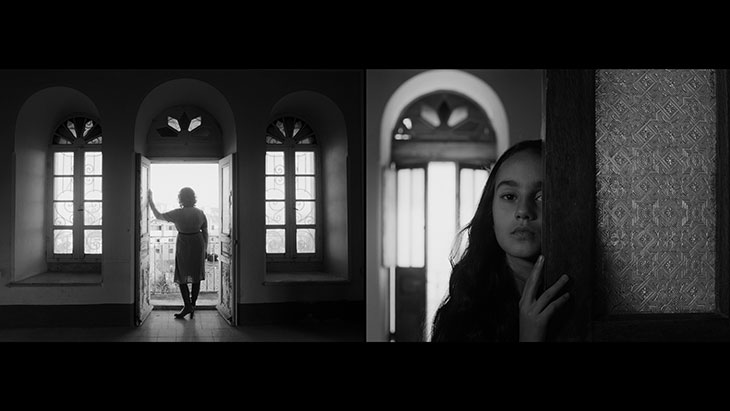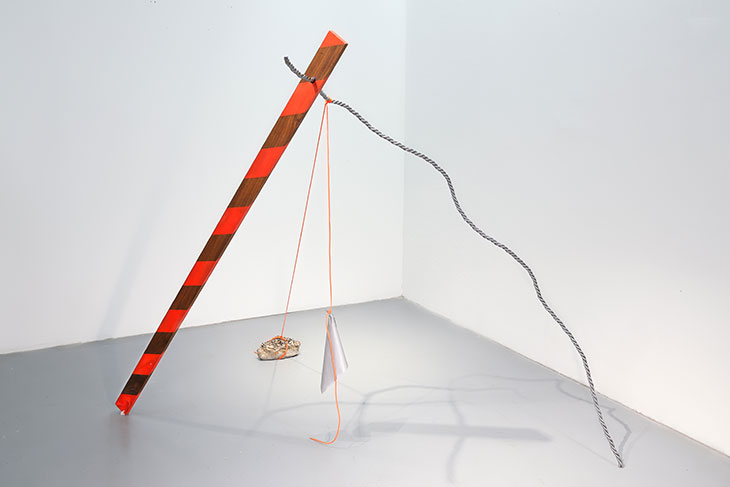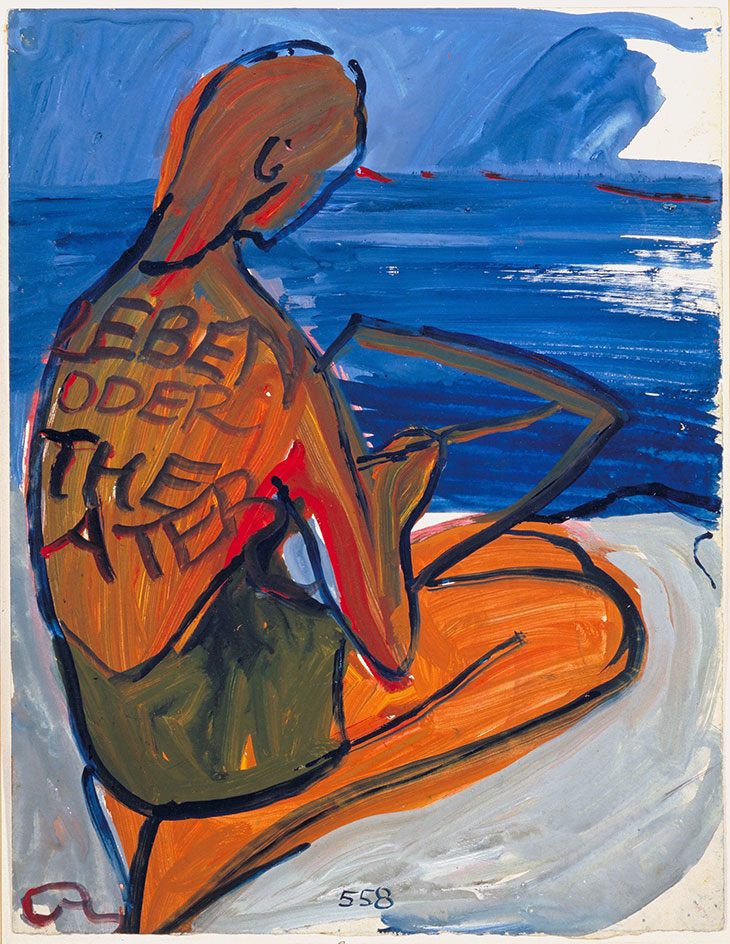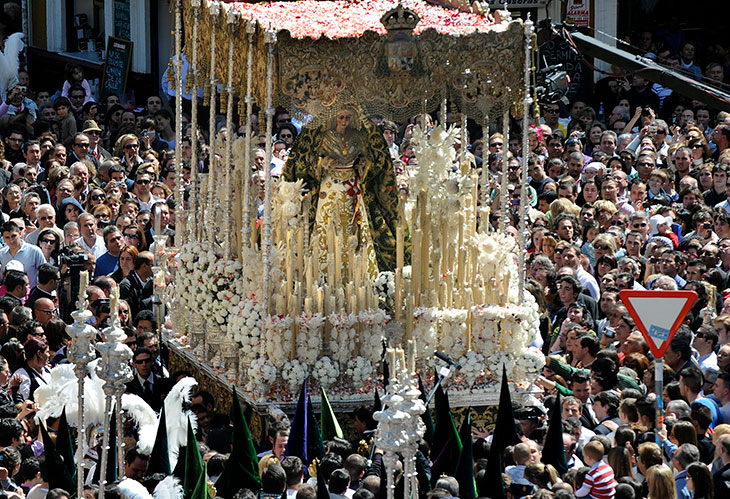Jasmina Cibic
I’d pick Larissa Sansour’s installation for the Danish Pavilion at the Venice Biennale, curated by Nat Muller. It was complex yet totally immersive. It’s so rare to come across art that delves deeply into critical analyses of the contemporary condition and still manages to have fresh ideas, which are not didactic and which do not simply use the currency of political engagement. Larissa’s work is a superb example of this – showing us paths of resistance against the forces that make it more and more difficult to realise such projects.
The other highlight is most definitely Jennifer Higgie’s Bow Down podcast. It’s about significant women artists from the past who deserve our attention. Listening to this – and following Jennifer’s Instagram feed (@bowdownpodcast), where she shares images and texts about the lives of some of the most inspirational women in art – has seen me through the recent political depression arising from events in Europe and the UK. If only women ruled the world… I bow down to the three mentioned above.
In Vitro (film still; 2019), Larissa Sansour and Søren Lind. Courtesy the artists

Andrea Geyer
I would propose the group of shows at the ICA in Philadelphia in their Fall season: ‘arms ache avid aeon: Nancy Brooks Brody / Joy Episalla / Zoe Leonard / Carrie Yamaoka: fierce pussy amplified’, curated by Jo-ey Tang; ‘Colored People Time: Banal Presents’, curated by Meg Onli; and ‘Michelle Lopez: Ballast & Barricades’, curated by Alex Klein.
Barricade (2018), Michelle Lopez. Courtesy the artist and Simon Preston, New York

Nick Goss
My highlight of the year was one of the last shows I saw, ‘Charlotte Salomon: Life? Or Theatre?’ at the Jewish Museum in Camden (until 1 March 2020). The tragic backstory is well known, but it does not do justice to the playful depictions of a young girl’s life contained in these fragile watercolours. Wobbly outlines interchange with beautiful passages of blues and mauves to form complex images that manage to be both charming and deeply moving.
Leben? oder Theater? Ein Singspiel (‘Life? Or Theatre? A Play with Music’; 1941–42), Charlotte Salomon. Jewish Historical Museum, Amsterdam. © Charlotte Salomon Foundation

Lubaina Himid
Claudette Johnson’s beautiful and deeply moving exhibition of pastel drawings ‘I Came to Dance’ at Modern Art Oxford this summer highlighted the immense importance of this British artist to any discussion about drawing, about people, and about the significance of the creative relationships between artists and their friends. It was beautifully curated; both spare and full at one and the same time.
Another highlight was Magda Stawarska Beavan’s double-venue exhibition project in Vienna, which took place at MAG3 Project Space and the Polish Institute. It was an opportunity to appreciate her evocative sound installations, her subtle video work with paper structures and eerily sumptuous screen prints. The large recent works depicting foliage crushed against a gate in Casablanca and a synagogue door in Berlin are hand-pulled screen prints over-painted and made sculptural by being cut.
There’s also Rebecca Chesney’s latest publication, the gorgeous Searching the Shadows, documenting works from 2000 to 2019. As curator Clarissa Corfe says in the introduction: her work sends our imaginations into overdrive as she skews how we perceive and relate to the natural world.
Hew Locke
This year I finally travelled to see Semana Santa in Seville. I had first visited the city 20 years ago, and saw and became obsessed with La Macarena, in her chapel. She is a 17th-century life-sized wooden statue of the Virgin of Hope – popularly believed to have been carved by a woman – exquisitely dressed in one of her numerous jewelled robes. La Macarena and the other baroque votive images I saw there became a huge influence on my work. But it was not until this year that I managed to come for Easter Holy Week to see her and numerous other devotional carvings carried through the narrow streets by penitents. Together with the intensely dramatic music of the marching bands, it was an overwhelming and highly emotional experience.
La Macarena Virgin paraded in a Holy Week procession in Seville. in April 2010. Photo: Cristina Quicler/AFP via Getty Images

Ibrahim Mahama
I think the highlight of the year for me was seeing the Chicago Architecture Biennale, as well as the various performances as part of the Manchester International Festival. The Bamako Biennale 2019 dedicated to photography was also very strong, including its talks programme and the visits the curatorial team organised to various homes to see family archives and have personal conversations with veteran practitioners. It was much needed.
Finally, I’d like to mention the Lagos Biennial and Lubumbashi Biennale. The choices of artists and spaces were deeply political. There seems to be much promise for future models of biennials.
Agnieszka Polska
I was really touched by Help the Dead by Every Ocean Hughes, staged in August at the KW Institute for Contemporary Art in Berlin, performed by Geo Wyeth and Colin Self and based on the experience that came from Every’s participation in death doula workshops (a death doula is a midwife for the dying). Every created a complex, well-written and precise theatrical piece that takes on the themes of social transformation, queerness, tenderness and death.
R.H. Quaytman
This year I finally had the opportunity to visit a museum in Brussels that in my opinion should be much better known, the Musée Wiertz. To make a living Antoine Wiertz (1806–65) painted portraits but refused to sign them. He donated his entire studio, with all the paintings, to the Belgian government, which has responsibly preserved it as a museum since his death. This extraordinary space is filled with paintings, some of which barely fit into the room.
The paintings shocked me. Imagine saying that these days. They are a howl of protest against war and poverty framed as a war between heaven and hell. I was struck by how feminist his choice of subject matter seems to be. This place was important not only to all the Belgian Surrealists, including Magritte and Marcel Broodthaers, but also, to my surprise, Walter Benjamin, who cites him repeatedly in his discussions of photography (Wiertz also wrote, and was ahead of his time on the topics of history, criticism and photography). His museum is a site-specific installation. It is like going to see an R-rated film replete with war, sex, giants, gods, devils, cannibalism and a dog painted to look like he is sleeping in a little hole in the wall. It was inspiring!
The Premature Burial (1854), Antoine Wiertz. Musée Wiertz, Brussels. Photo: Wikimedia Commons (public domain)

Bob and Roberta Smith
Claudette Johnson’s one-person show at Modern Art Oxford. Claudette has spent her life documenting and beautifully portraying her friends, her generation – members and the children of the Windrush era. She is a powerful and generous painter and the works are an expressive gesture of affirmation. I was honoured to attend the opening, where I was reminded of how many of her generation of black artists have had to ‘sit out’ decades while their white, mainly male colleagues were feted. I love her work: it is open, large and full of optimism and celebration.
My other highlight was the election of Rebecca Salter as president of the Royal Academy. Last year I had an exhibition at the RA, which was about my mother, the painter Deirdre Borlase (‘The Secret to a Good Life’; 4 September 2018–3 February). Deirdre would submit her works to the academy using just her last name so that selectors would not know that she was a female artist. The institution has done some wonderful things but in its 250-year history it has never had a female president – until now. It’s long overdue, but Rebecca Salter’s election is a fantastic moment.
Standing Figure with African Masks (2018), Claudette Johnson. Tate, London. Photo: Andy Keate; courtesy the artist and Hollybush Gardens; © Claudette Johnson



